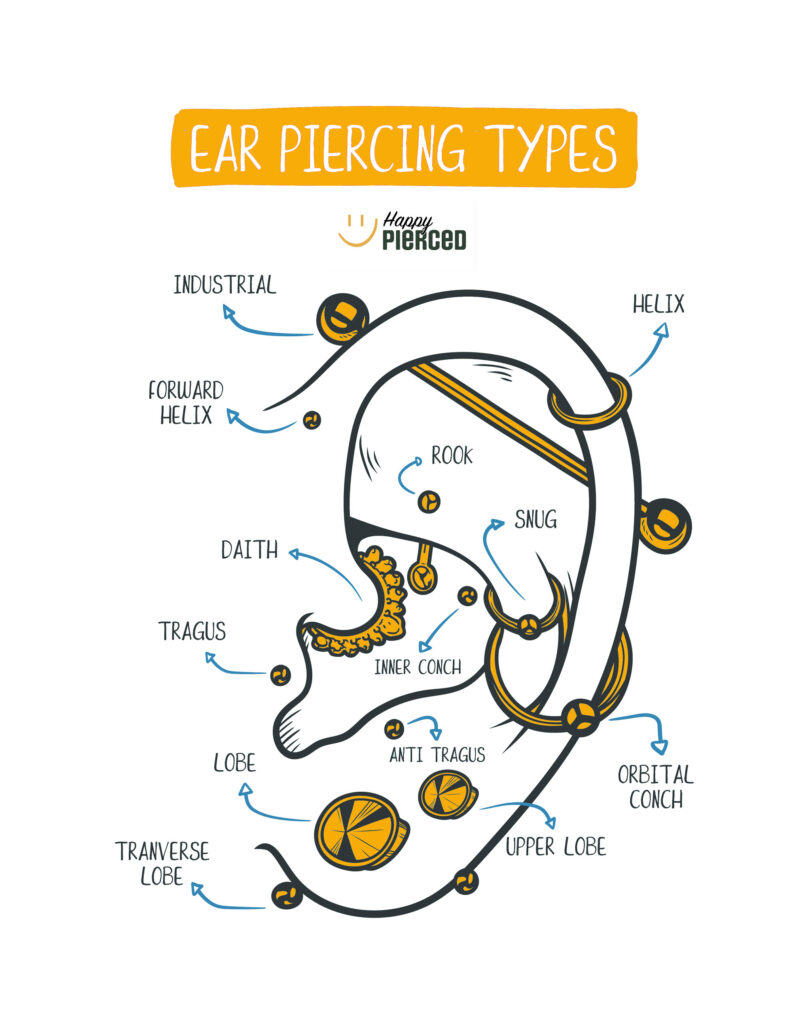Ear Piercing Chart Guide
The Different Types of Ear Piercings
What Is an Ear Piercing Chart?
An ear piercing chart is a visual guide that shows you all the different spots you can get pierced on your ear. It’s especially helpful when planning your next look or figuring out what piercing goes where—because let’s be real, names like “rook,” “snug,” and “daith” don’t exactly explain themselves.
From your classic lobe piercing to more adventurous cartilage options, the chart gives you a roadmap for building your dream ear setup. It also helps you understand healing times, jewelry options, and which styles can be combined.
Why Use an Ear Piercing Chart?
Using an ear piercing chart makes it easier to:
- Decide which piercings complement each other
- Understand healing times and placement
- Communicate clearly with your piercer
- Customize your look with confidence
At Happy Pierced, we offer a simplified ear piercing chart for beginners, along with expert guidance during your appointment to make sure your look matches your vibe.
Popular Piercing Placements on the Ear Piercing Chart
Lobe Piercing: The most traditional and beginner-friendly option.
Helix Piercing: Placed on the upper outer rim—great for hoops or studs.
Tragus Piercing: Located on the small flap in front of your ear canal.
Daith Piercing: Tucked into the inner ear fold and loved for its unique style.
Forward Helix, Rook, and Conch: Stylish cartilage options that add dimension to your curated ear.
Check out our piercing services page to learn more about each piercing and what to expect.
Simplified Ear Piercing Chart Breakdown
Lobe – Soft lower part of the ear. Great for beginners.
Upper Lobe – Slightly above the standard lobe, perfect for stacking.
Helix – Outer upper edge of the ear. Great for hoops or studs.
Forward Helix – Cartilage at the front/top of your ear, closer to your face.
Tragus – Small flap of cartilage in front of your ear canal.
Daith – Curved fold of cartilage just above the ear canal opening.
Rook – Fold of cartilage above the daith.
Conch – Inner shell of your ear. Can be styled with large hoops or studs.
Industrial – Two piercings connected by one barbell across the upper ear.
Snug – Horizontal piercing along the inner ridge of the outer ear.
Detailed Ear Piercing Types
Lobes
The most common and universally accepted piercing type, lobe piercings pass through the soft, fleshy part of the earlobe. They are known for their quick healing times and minimal pain during the piercing process, making them a popular choice for first-time piercees.
Upper Lobe
Similar to the standard lobe piercing but located higher on the earlobe, upper lobe piercings allow for multiple earrings along the ear’s edge. They offer a subtle way to expand an earring collection and are just as easy to heal.
Transverse Lobe
A unique take on the lobe piercing, the transverse lobe features a horizontal barbell that passes through the earlobe, rather than the traditional vertical piercing. It creates an intriguing visual effect but may have a slightly longer healing time due to the piercing’s orientation.
Anti-Tragus
Positioned opposite the tragus on the outer rim of the ear, the anti-tragus piercing penetrates the cartilage above the earlobe. It’s a more unusual choice that stands out and can be adorned with small studs or hoops.
Tragus
The tragus piercing goes through the small cartilage flap right in front of the ear canal. Due to its prominent location, it’s an ideal spot for subtle jewelry that adds an edge to any look. Healing times can vary given the cartilage’s density.
Inner Conch
Located in the ear’s inner shell, the inner conch piercing punctures the central cartilage. It’s versatile, allowing for studs or rings, and offers a distinctive look. The healing process can be lengthy due to the cartilage’s thickness.
Daith
The daith piercing is located in the innermost fold of the ear cartilage, directly above the ear canal opening. It has gained popularity not just for its aesthetic appeal but also for anecdotal claims that it can help alleviate migraines. Healing can be complex due to its location.
Rook
Situated along the inner ridge of the ear cartilage, just above the tragus, the rook piercing is both subtle and striking. It requires a curved barbell due to the area’s shape, and while stylish, it can have a longer healing period due to the cartilage’s thickness.
Snug
The snug piercing is located in the inner cartilage halfway down the ear’s outer rim. This piercing can be quite painful due to the dense cartilage and typically requires a longer healing time. It’s perfect for those seeking a unique and bold statement.
Forward Helix
Positioned at the top front of the ear’s cartilage, near the root of the helix, the forward helix piercing offers a sophisticated and trendy look. It can be done as a single piercing or in multiples and is often adorned with small studs.
Industrial
An industrial piercing consists of two punctures connected by a single straight barbell across the ear’s upper cartilage. It’s a bold and distinctive choice that stands out, but it requires a longer healing time and careful aftercare.
Helix
Located along the upper outer cartilage, helix piercings offer versatility in jewelry choice, from studs to hoops. They’re a classic choice for adding an edge to your ear decor, with a moderate healing time due to the cartilage’s nature.
Orbital Conch
An orbital conch piercing involves two holes pierced through the ear’s cartilage, allowing a single piece of jewelry, usually a hoop, to orbit through both. It combines the look of the conch and orbital piercings for a unique, eye-catching style.
Each of these piercings offers a way to express personal style and individuality through body art. Whether you prefer the simplicity of a lobe piercing or the bold statement of an industrial, there’s an ear piercing type to suit every taste and preference.

